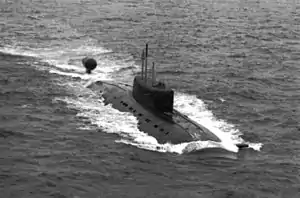Submarine incident off Kildin Island
The submarine incident off Kildin Island was a collision between the US Navy nuclear submarine USS Baton Rouge and the Russian Navy nuclear submarine B-276 Kostroma near the Russian naval base of Severomorsk on 11 February 1992. The incident occurred while the US unit was engaged in a covert mission, apparently aimed at intercepting Russian military communications. Although most sources claim that the American submarine was trailing her Russian counterpart, some authors believe that neither Kostroma nor Baton Rouge had been able to locate each other before the collision.
| Submarine incident off Kildin Island | |||||||
|---|---|---|---|---|---|---|---|
| Part of Operation Holy Stone | |||||||
 USS Baton Rouge awaiting disposal at Mare Island (1995) | |||||||
| |||||||
| Belligerents | |||||||
|
|
| ||||||
| Commanders and leaders | |||||||
|
|
| ||||||
| Strength | |||||||
| 1 Los Angeles-class submarine | 1 Sierra-class submarine | ||||||
| Casualties and losses | |||||||
| 1 nuclear submarine heavily damaged | 1 nuclear submarine damaged | ||||||
 Location within Russia | |||||||
Background
Following the fall of the Soviet Union in 1991, uncertainty prevailed among the US intelligence community about the attitude of the former Soviet forces, especially the strategic assets that remained under Russian control. The US government tasked the Navy to continue keeping a close watch on the main bases of Russian nuclear submarines to monitor developments.[4] During the cold war, this type of submarine surveillance was known as "Operation Holy Stone;" submariners nicknamed the program "Operation Pinnacle" or "Bollard".[5] Author Jeffrey T. Richelson maintains that "Holy Stone" continued unabated and that the 1992 incident was part of the operation.[6] This intelligence-gathering included tapping Soviet submarine communication cables, recording the pattern of noises from Soviet submarines, and observing submarine-launched ballistic missile tests.[7]
Collision
Blind encounter
The collision occurred at 8:16 pm local time,[8] at a point slightly over 12 miles from the shoreline, in waters that the United States regarded as international, and that Russia considered as five miles inside the Russian territorial sea (due to the Russian use of a straight baseline). The mission of Baton Rouge off Severomorsk was reportedly the recovery or delivery of intelligence-monitoring devices on the seabed.[7] The American press claimed that the submarine had been checking wireless traffic between Russian bases,[9] but the Russian counterpart asserted that the two boats were engaged in a 'cat-and-mouse game',[10] an opinion also supported by several Western sources.[11][12] According to naval analyst Eugene Miasnikov, the amount of antisubmarine surveillance deployed by the Russians along their shores makes the first possibility implausible. He asserts that the second argument also seems to be weak given the circumstances and that the collision itself seemed to have happened by chance. The breaking waves and the shallow waters of that area of the Barents sea prevented early enemy detection by either submarine. At the time of the incident, both vessels were using only passive sonars.[13] Miasnikov maintains that the submarines of the Los Angeles class are unable to detect acoustic signals from targets located within a cone of 60 degrees astern, thus the most probable scenario was that Kostroma approached Baton Rouge from behind. Indeed, the collision took place when the Kostroma was surfacing, hitting the US submarine underneath on her aft section. The Sierra class sonar is also ‘deaf’ to the aft direction; her usual pattern of acoustic search is moving along a loop course. The incident, however, implied that Russian attack submarines are capable of avoiding passive acoustic detection, at least under certain conditions.[7]
Damage

Both submarines sustained damage, but no casualties were reported. Russian reports and American aerial surveillance agree that Kostroma's sail was dented on her front section. Russian navy sources reportedly found pieces of composite material from Baton Rouge's anti-sonar tiles.[7][14] The US Navy claimed that besides some scratches, dents, and two minor cuts on her port ballast tank,[15] Baton Rouge did not suffer major damage. But in any case, it was serious since any rupture on the single hull of Baton Rouge would have compromised her pressure resistance.[14] The deactivation of Baton Rouge was announced on 17 September 1993,[16] although some sources claim that the American submarine had already been taken out of service less than a year after the incident,[17] in January 1993.[18] According to Gregory Stitz, curator of Arkansas Inland Maritime Museum,[2] and some European sources,[1] the costs of repairing the damaged pressure hull, along with a programmed refueling, were well beyond the planned budget. Therefore, the US Navy chose to decommission the submarine. Russian naval officers alleged that the US submarine had become a constructive total loss right after the collision.[19] Baton Rouge was deactivated at Mare Island shipyard on 1 November 1993 and eventually scrapped at the Puget Sound Naval Shipyard in Bremerton, Washington.[20] As for Kostroma, she was laid up on 28 March 1992 and had been fully repaired at Nerpa shipyards in Snezhnogorsk by 29 June 1992. The Russian submarine was temporarily renamed Krab, before recovering her original name in November 1996. After a huge overhaul, again at Nerpa, she returned to service in 2005.[21]
Political consequences

The incident produced intense embarrassment in Washington.[13] Russia complained via diplomatic channels, and the Pentagon quickly acknowledged that a collision had occurred, contrary to an official policy at the time. A meeting between Secretary of State James Baker and Russian president Boris Yeltsin was arranged immediately. The Russian Navy accused the United States of continuing intelligence operations around Russia's home waters despite the end of the cold war. All of this prompted the US Navy to stop some specific submarine activities off Russian bases, such as tapping underwater cables or intercepting wireless communications.[23] This measure, however, did not prevent a later incident in March 1993, when the Sturgeon-class submarine USS Grayling collided with a Delta-class submarine, K-407 Novomoskovsk off Kola peninsula.[24]
See also
Notes
- "In late 1993, it was announced that one of the oldest Los Angeles class boats, the USS Baton Rouge, would be decommissioned and placed in reserve. The official reason for this was that the boat was due for a very expensive refueling and the cost of this could not be justified in the current environment. However, confidential European sources have pointed out that the Baton Rouge was involved in a collision with a Russian Sierra class submarine and had not been to sea since. This, they suggested, pointed to serious pressure hull damage rather than refueling costs as being responsible for the decommissioning." Warships Forecast, February 1997.
- "Baton Rouge was due to be re-fueled, a lengthy and expensive proposition. Military budget cutbacks apparently did not allow for the additional expense of the repairs needed, and Baton Rouge was placed "In Commission, In Reserve" on 01 November 1993. This status meant that the Navy effectively retired Baton Rouge from service. Most of the crew was reassigned to other duties, and preparations were begun to safely shut the nuclear reactor down so that the radioactive fuel rods could be removed later, during the scrapping process (known as "submarine recycling" and performed at the Puget Sound Naval Shipyard in Bremerton, Washington). She had been in service less than 16 years (from the time she was commissioned until she was placed in ICIR status). (...) The extent of the damage has not been publicly disclosed, but must be inferred from the fact that the Baton Rouge was decommissioned, rather than repaired." Stitz, Gregory: Peacetime Submarine losses. Texas Maritime Academy, Texas A & M University at Galveston, 1996.
- "Sub wreck won't alter US policy". NewspaperArchive.com. Independent Examiner by Associated Press, Feb 19, 1992, p. 14. 19 February 1992. Retrieved 1 July 2023.
- Sontag & Drew, p. 586.
- Reed, p. 1.
- Richelson, Jeffrey T. (2008). The US intelligence community. Westview Press, p. 234. ISBN 0813343623.
- Eugene Miasnikov (April 1993). "Submarine Collision off Murmansk". The Submarine Review: 6.
- RFE/RL research report: weekly analyses from the RFE/RL Research Institute, Volume 1, p. 52. Radio Free Europe/Radio Liberty, Inc., 1992.
- John H. Gushman Jr. "Two Subs Collide off Russian Port", The New York Times, 19 February 1992.
- Artur Blinov and Nikolay Burbyga, "Underwater Incident in the Kola Gulf," Izvestia, 20 February 1992 p.1; Nikolay Burbyga and Viktor Litovkin "Americans Not Only Helping Us, But Spying on Us. Details of Submarine Collision in Barents Sea," Izvestia, 21 February 1992, p. 2.
- Jane's defence weekly: Volume 17, p. 352. Jane's Pub. Co., 1992.
- Schwartz, Stephen I. (1998). Atomic audit: the costs and consequences of U.S. nuclear weapons since 1940. Brookings Institution Press, p. 306, note 89. ISBN 0815777744.
- Moore, Robert: A time to die: the untold story of the Kursk tragedy. Crown Publishers, 2002, p. 116. ISBN 140005124X.
- "However, because American boats are of single-hull design, these tears were ruptures in her pressure hull, and thus represented significant damage." Stern, p. 184.
- The larger cut was five-feet long as per Reed, p. 153.
- Navy to decommission Los Angeles-class attack sub Defense Daily, 17 September 1993.
- Linder, Bruce (2005). Tidewater's navy: an illustrated history. Naval Institute Press, p. 248.
- Polmar, Norman & Moore, Kenneth J. (2005). Cold War submarines: the design and construction of U.S. and Soviet submarines. Potomac books inc., Chapter 17, note 57. ISBN 1574885308.
- Американцы тогда, правда, сумели доползти до своих берегов, но повреждения были столь впечатляющими, что новейший атомоход восстановлению не подлежал и был немедленно списан на металлолом.
Шигин, Владимир: АПРК "Курск". Послесловие к трагедии. Олма-Пресс, 2002, p. 401. ISBN 522403308X. - "Submarine Photo Index". www.navsource.org. Retrieved 18 September 2018.
- "945 Sierra class". warfare.be. Archived from the original on 19 February 2013.
{{cite web}}: CS1 maint: bot: original URL status unknown (link) - На Костроме я побывал, будучи в Видяево. По случайному стечению обстоятельств она входит в состав той же 7-й дивизии, что и Курск . На боевой рубке Костромы нарисована красная пятиконечная звезда с цифрой 1 в центре. Так в годы Великой Отечественной войны наши подводники вели счет своим победам. Что ж, цифра на рубке нашего атомохода появилась тоже не случайно. На мой вопрос, а не ругается ли начальство на такую символику, командир Костромы Владимир Соколов ответил так: "Сначала, конечно, морщились – мол, американцы нам теперь друзья. Затем вроде попривыкли, ну а после Курска кто и что может мне сказать на этот счет! Разве только то, что цифра уж очень невелика!. Шигин, Владимир: АПРК "Курск". Послесловие к трагедии. Олма-Пресс, 2002, p. 401. ISBN 522403308X.
- Sontag & Drew, p. 587.
- Stern, p. 185.
References
- Sontag, Sherry; and Drew, Christopher (1998). Blind Man's Bluff: The untold story of American submarine espionage. Thorndyke press. ISBN 0786218762
- Stern, Robert (2007). The hunter hunted: submarine versus submarine encounters from World War I to the present. Naval Institute Press. ISBN 1591143799
- Reed, Williams (2003). Crazy Ivan: Based on a True Story of Submarine Espionage. IUniverse. ISBN 0595265065